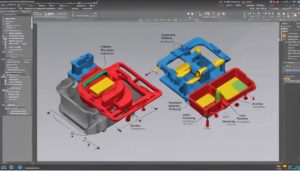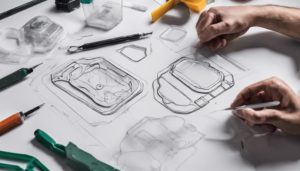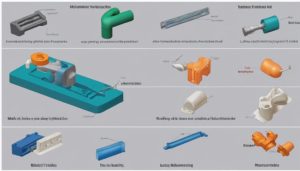Mold injection involves precise steps: resin heating with bands and thermocouples, screw rotation for melting aided by external bands, polymer flow from heat and screw design with a one-way valve, and controlled high-pressure injection into molds. The process guarantees proper resin melting, controlled flow, and cooling for shaping plastic components. Understanding each step optimizes the production of intricate parts efficiently.
Injection Molding Resin Heating Process
The injection molding resin heating process is a pivotal stage in the injection molding operation. Heating bands within the machine meticulously raise the resin to its necessary temperature for ideal flow and molding consistency. As the resin enters the barrel, thermocouples strategically placed within the machine monitor and regulate the temperature to guarantee precise heating. This controlled heating is essential to prevent thermal degradation of the material and maintain uniformity in the molten plastic as it flows into the mold cavity.
Maintaining the correct temperature is critical as it directly impacts material flow and the quality of the final plastic part. The heating bands, in conjunction with the thermocouples, play an essential role in regulating the temperature throughout the injection molding cycle. By carefully controlling the temperature of the resin, the manufacturing process can achieve excellent results in terms of mold filling, part integrity, and overall production efficiency.
Screw Rotation and Resin Melting

Screw rotation in the injection molding process plays a vital role in initiating the resin melting through drag flow, where polymer molecules generate frictional heat as they slide over each other. This process is essential for preparing the resin for molding.
External heating bands wrapped around the injection barrel provide additional heat to assist in the resin melting process. The design of the screw is critical, with different zones such as feed, melt, and metering, all playing a role in optimizing resin melting.
The one-way valve at the screw tip guarantees that the melted resin flows in a controlled manner towards the injection mold's nozzle, maintaining precision and efficiency in the process. By carefully managing screw rotation, drag flow, and external heating, manufacturers can enhance resin melting, leading to better final molded products.
Polymer Flow and Frictional Heat

Within the intricate dynamics of polymer flow within the injection molding process, the interaction between screw rotation and drag flow generates essential frictional heat, important for ideal resin melting. As the polymer molecules slide over each other due to the screw's rotation and drag flow, frictional heat is produced in the melt zone of the screw, aiding in the melting process. This controlled generation of frictional heat ensures proper viscosity for the molten polymer to flow smoothly through the system. Additionally, external heating bands surrounding the injection barrel provide supplementary heat to facilitate the polymer's melting and flow.
Moreover, the screw's one-way valve at the tip plays a significant role in directing the molten material towards the mold cavity. This valve ensures that the material flows in only one direction, towards the mold's nozzle. Subsequently, the hydraulic push forward by the injection cylinder pushes the molten material into the mold cavity, where it takes the shape of the intended product. This fluid process, guided by frictional heat and controlled flow mechanisms, is important for the successful execution of injection molding processes.
Injection Barrel and Heating Bands

Located at the core of the injection molding process, the injection barrel and its heating bands are integral components responsible for ensuring the proper melting and flow of resin for injection. The injection barrel houses the screw, which plays an essential role in pushing and melting the resin for injection.
Heating bands encircling the injection barrel provide additional heat to facilitate the proper melting of the resin. Thermocouples located within the barrel and nozzle serve to control and monitor the temperature of the resin during the heating process.
Moreover, the screw incorporates a one-way valve at its tip, allowing the molten material to flow in only one direction towards the injection mold. Additionally, external heating bands contribute by generating frictional heat, aiding in melting the polymer molecules effectively for the injection molding process.
Material Injection and Mold Molding

The process of material injection in mold molding involves transforming resin pellets into a molten state before injecting them into a metal mold cavity under high pressure. Once inside the metal mold cavity, the molten material takes the shape of the mold. The high pressure guarantees that the material fills all the intricate details of the mold, allowing for the production of complex shapes with high precision. Cooling the molten material inside the mold solidifies it into the desired shape. This method is efficient and cost-effective, making it ideal for mass production of plastic components.
| Key Points | Details |
|---|---|
| Resin Pellets | Transformed into molten material before injection |
| Molten Material | Injected into metal mold cavity under high pressure |
| Cooling | Solidifies the material into the desired shape |
Material injection and mold molding offer an efficient and precise way to manufacture plastic components in large quantities, making it a preferred method for industries requiring mass production of items with complex shapes.
Frequently Asked Questions
What Are the 5 Steps of Injection Molding?
The five key steps of injection molding include:
- Feeding and melting thermoplastic in the machine's hopper.
- Injecting molten plastic into the mold cavity under pressure.
- Holding the plastic for proper packing.
- Cooling the plastic to solidify in the mold.
- Ejecting the cooled parts from the mold using ejector pins.
Additional finishing processes, such as polishing or dyeing, may be applied if necessary before removing excess plastic and preparing the components for distribution.
What Is the Mechanism of Injection Molding?
The mechanism of injection molding involves a precise process wherein plastic resin pellets are melted and injected into a mold cavity under controlled pressure. This allows the material to take the shape of the mold and solidify upon cooling.
Ejection systems are then employed to remove the cooled plastic part from the mold for subsequent finishing. This method guarantees consistent and accurate production of plastic parts for various industries.
What Are the 3 Main Parts of the Injection Mold?
The three main parts of an injection mold are the mold cavity, core, and mold base.
The mold cavity is where molten plastic is injected and shaped to form the final product.
The core is responsible for creating internal features of the part and is typically mounted on the mold base.
The mold base provides support for the cavity and core components and also houses the cooling system, essential for successful injection molding processes.
What Is the Life Expectancy of an Injection Mold?
The life expectancy of an injection mold varies based on factors including material, design, and maintenance. High-quality molds made of hardened steel can endure up to 1 million cycles or more, while aluminum molds have a shorter lifespan. Proper maintenance, cleaning, and repair practices play an essential role in extending the mold's life and ensuring peak performance.
Factors like mold design complexity, resin type, and production conditions also influence the mold's longevity. Regular monitoring of wear, surface degradation, and dimensional changes is crucial for maximizing mold lifespan and part quality.
Conclusion
To sum up, the process of mold injection involves a series of intricate steps such as resin heating, screw rotation, polymer flow, and material injection.
The importance and efficiency of this method allow for the production of high-quality and complex molded parts.
Essentially, mold injection can be likened to a symphony of synchronized movements, where every component plays a vital role in creating flawless end products.







